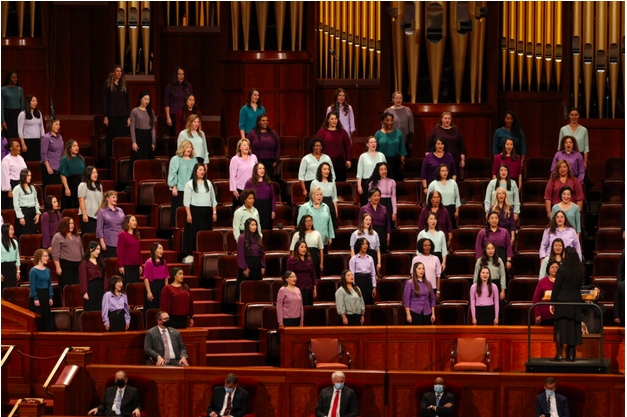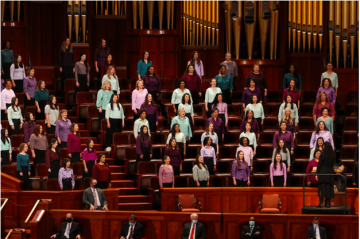Nicole is an adult convert, a woman of color, and a professional diplomat. She blogs at nandm.sbitani.com and writes microfiction @nsbitani on Twitter. The content of this post does not represent the views of the U.S. Department of State or any other U.S. Government agency, department, or entity. The thoughts and opinions expressed here are solely those of the author and in no way should be associated with the U.S. Government.

I grew up in a part of the United States with a huge Korean American population. Yet, I’ve only met one Korean American member of the Church of Jesus Christ of Latter-day Saints in all of the four wards I lived in in my home state of Virginia. My non-member husband is Palestinian, and we’ve only met one member of Arab descent in all of our home state.
In one sense, the problem is self-reinforcing. The wards and branches I attended in northern Virginia are overwhelmingly white and wealthy relative to the surrounding population. As member missionaries share the Gospel with friends, colleagues, and neighbors – people who tend to have similar backgrounds to one another due to social and economic factors – the gaps widen. Moreover, those who feel they do not fit the mold of the individuals and groups they see in the chapel may not see a place for themselves in the Church. In the worst case scenarios, members and leaders may make investigators and new converts feel unwelcome with judgments, assumptions, or hurtful comments and behavior.
When I’ve served in callings including Young Women and Relief Society, I have noticed that the lack of diversity is not limited to membership rolls alone. Even in auxiliaries with members of color, LGBTQ+ members, immigrants, and others on the books, I noticed that the rate of Church attendance and participation of minority members in everything from ministering to activities was disproportionately low. We must ask ourselves why that is the case.
Like many, I have had experiences with well-meaning but culturally insensitive members. Recently, I attended a Relief Society book club activity on Zoom for my English branch in South Korea. That month we had read a historical mystery set in Joseon Dynasty-era Korea written by a Korean diaspora author whom I love. Early on in the discussion, multiple sisters complained about the difficulty of character and place names. Another lamented that the characters didn’t speak in a more “American” way given that the book was in English. Several made sweeping generalizations about “Asian” culture – encompassing about 60% of the world’s population. I was the only Korean American in attendance and only woman of color until another Asian woman of non-Korean descent joined partway through the event.
Not all the sisters were offensive. But enough made ignorant comments that I spent a good portion of the Relief Society activity thinking about people throughout my life who had ridiculed the food I ate growing up, butchered the pronunciation of my Korean middle name, told me my parents were right to give me an English first name and emphasize assimilation, mocked my family’s accents, made fun of traditional Korean dress, mixed up my heritage with Chinese or Japanese or whatever else seemed interchangeable to them, and so on. I silently hoped that the other Asian woman who joined our call later had not heard the worst of the book club comments. I did not have the energy that night on Zoom to try and educate these Relief Society sisters, sisters whom I love and admire and respect. I just wish they would take the time to learn how to make Relief Society more welcoming for someone like me.
I have seen the same challenges play out in countless wards in the Western world during my travels and found it especially acute in the United States. In the Beyond the Block podcast’s Conference Recap episode, Brother James Jones commented, “We clearly have a race issue in the Church still, and even where I am in Harlem, my ward is predominantly white, despite the neighborhood being overwhelmingly Black and I can’t help but acknowledge that there’s no way that’s an accident.” Sadly, I took the relatively homogeneous appearance of members of the Church I encountered for granted. For that reason, seeing the multicultural choir singing on the October 2021 General Conference broadcast struck me like lightning.
The multicultural choir represented 39 countries and 35 languages across 180 people who choir member Thom Reed pointed out hail “from homelands on every populated continent on the earth”. It was the most diversity in appearance I had ever seen in a General Conference. From skin color to body size to age to hair texture and style, the multicultural choir showed me what I didn’t even know I was missing – what my heart ached for from my congregations and from my spiritual leadership. Choir member Benny Yamagata said, “I think it’s the start of a new era and the church, one of the multicultural and global church as opposed to just one focused here in Utah.”
In making the beautiful vision of a truly multicultural and global Church a reality, we should heed the words of Elder D. Todd Christofferson:
It breaks my heart if someone comes and is very vulnerable and says, ‘I want to try it. I want to be here,’ and then get a cold shoulder or a lack of interest. And that’s tragic. It really is tragic. We have to be better than that. The diversity we find now in the Church may be just the beginning. Frankly, I think we will see greater and greater diversity. In the ancient Church there was tremendous diversity. And it’s not just diversity for diversity’s sake but the fact that people can bring different gifts and perspectives, and the wide range of experience and backgrounds and challenges that people face will show us what really is essential in the gospel of Christ. And that much of the rest, that has been perhaps acquired over time and is more cultural than doctrinal, can slip away and we can really learn to be disciples.
It is crucial to note that he doesn’t say the offense is the fault or responsibility of the vulnerable person; rather, he urges us: “We have to be better than that.” He also recognizes that diversity benefits the Church and all its people, not just the marginalized. Elder Dieter F. Uchtdorf also taught, “the diversity of persons and peoples all around the globe is a strength of this Church.”
We are the body of Christ as Paul acknowledged in 1 Corinthians 12:12-27. We must be one, but we don’t have to be the same to be unified. I have a testimony that the Savior loves me and all of my spirit siblings for who we are, including our differences. I look forward to the day when all the congregations I attend reflect that simple truth.






5 Responses
I’m so sorry for the ignorance of others and appalled at their comments. Years ago I was at the community pool with my Korean son (adopted) when some kids started calling mim chink eyes. I was going to go drown them. Brian stopped me and said their ignorance wasn’t worth the rage. I still rage about it.
Ward and stake boundaries are one major factor. Imagine being able to choose your congregation.
Thank you, Nicole. I hope that Benny Yamagata’s impression that the choir represented the start of a new era in the Church is correct.
I’ve attended many branches/wards over the years. I’m a Caucasian from New Zealand, and I’ve attended wards/branches where the predominant race or culture is not mine. People have often been welcoming and kind, but it can still be quite challenging. There can be culture shock (even when you move to a new ward/stake in a multicultural city), I haven’t always understood the social “rules”, and stumbled through, making/breaking friendships unaware.
I’ve been working in Italy over the last two months, and when possible, have attended a nearby branch. At first, I thought I would not understand anything, and sneak out after the sacrament. When I arrived though, I was warmly welcomed by the branch members. They spoke to me in English as best they could (I tried my best limited Italian) and they asked me questions to get to know me. A young lady came over and translated for me during sacrament meeting, and a Texan elder translated for me during the second hour. I felt so accepted and welcomed by these members. I hope I can be more like them when I go attend at home.
I grew up in Southern California where diversity has been the norm rather than the exception and it hurts to see that it has been so difficult for you and others. It was thrilling to see October 2023 conference with the variety of faces and accents. It is my belief that our American, white faces will be outnumbered by all the others. Then it will truly be a Worldwide church. We ain’t seen nothin’ yet.